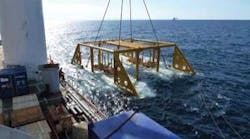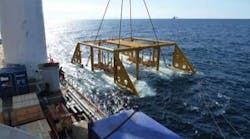New sensor system generates multi-phase measurements downhole
Terje Baustad
Emerson Process Management
From pressure and temperature information to sand erosion and corrosion monitoring, operators today know more about the inner depths of their oil and gas reservoirs than ever.
Such has been the speed of these technology developments around reservoir monitoring that many well intervention techniques, such as logging, perforating and plug setting, and impeded wellbore access (through sand eroded components for example) mercifully are becoming less and less frequent.
Despite these developments, however, there remains one missing downhole reservoir monitoring element – multi-phase meters and the ability to measure multi-phase flow downhole.
Multi-phase meters today provide crucial real-time information on flow conditions in the reservoir and are an important alternative to traditional well testing.
Through the accurate characterization of multi-phase flows, the meters can determine maximum oil production and gas handling capacity and can provide early warnings on threats to production, such as water breakthrough.
As of 2010, there were 3,314 multi-phase meters and wet gas meters installed worldwide, according to Gioia Falcone of Texas A&M University and Bob Harrison from Soluzioni Idrocarburi Srl. This figure is expected to double over the next 10 years.
Recent technical developments include the ability to mix effects and velocity profiles and to detect changes in fluid composition more rapidly using more compact versions. Furthermore, today there are multi-phase meters for all types of field conditions, covering the full operating range of 0 -100% watercut and 0 - 100% gas void fraction.
However, for all this progress, there is one crucial piece of information that multi-phase meters have not delivered consistently until now - the flow from individual wells and well zones downhole. The need for this information has increased all the more with the move towards complex well architectures.
Complex well architectures
The last few years have seen a growth in different types of well architectures, including multi-lateral, horizontal and multi-zone wells, and intelligent completions. In many cases, the rationale has been to increase well exposure, extend well reach and productivity, and reduce capital and operating costs.
Multi-lateral well technology from a single wellbore, for example, requires fewer production well slots to drain a reservoir, resulting in reduced subsea infrastructure costs, reduced costs for top-hole drilling, and accelerated production. Today, there are multi-lateral well examples throughout the world from Statoil's Glitne and Sleipner developments on the North Sea to Petrobras' developments in the Campos basin where Level 5 multi-lateral wells are deployed.
Extended reach wells have led to multiple production targets as well as an operator requirement to pinpoint production data not only from each wellhead but from each producing zone.
In such circumstances, real-time monitoring of downhole oil, gas, and water flows can improve production by providing input to the use of inflow control valves, for example. Furthermore, if a gas or water cone is detected in a multi-lateral well, such information can lead to the closure of an individual well where the incident occurs, rather than the complete well as is often the case.
While downhole multi-phase monitoring has been a focus for many years, to date, the direct monitoring of multi-phase flows has been hindered by a variety of factors ranging from cost to concerns over accuracy and the extreme conditions downhole. The result is that often multi-phase meters have provided only data on total production flow from all wells rather than flow from specific zones.
Flow sensor system
Against this backdrop, Emerson has developed a new flow sensor system that generates multi-phase flow measurements from downhole in the well.
The new system – Roxar Downhole Flow Sensor System – can generate multi-phase measurements, including fluid fractions and flow rates, from either single bore or multi-lateral configurations. This allows operators to control multiple production wells, measure the individual flow zones of oil, gas and water, and to establish optimum flow rate control.
Typical applications include zonal allocation in multi-zone wells where the downhole sensor can help allocate production from different zones; improved assessments of well productivity; reduced need for alternative well testing requirements; and improved production logging that provides more details on fluid distributions. This is important in horizontal and deviated wells where well deviations result in more unpredictable flow regimes.
Probably the most important application is detecting threats to production. If there is water breakthrough or gas encroachment in a particular well, for example, the problem can be detected early and only the branch of the well in question closed rather than the complete well.
Other production anomalies or warnings of transient behavior such as slugs also can be detected earlier. Actions, such as injecting water or gas into the reservoir for improved sweep efficiency, also can be monitored and the injection rate in each individual reservoir layer closely controlled. In this way, many of the causes for well intervention can be mitigated and any remedial action localized.
The new measurement principle is based on an electrode geometry sensor which allows for capacitance and conductivity measurements in separate sectors, in addition to the full cross-sectional area. This results in more combinations and more accurate fraction and phase measurements.
Rather than being able to perform only cross-sectional measurements, for example, the meter can perform both rotational near wall measurements and cross-volume measurements, thereby providing a comprehensive mapping of the flow regimes downhole. The meter is designed to handle all types of downhole flow regimes, from horizontal laminar flow to fully developed vertical annular flow.
The new system includes a new water cut measurement tool based on dual velocity measurements and a density sensor which measures the density of the fluid using gamma rays.
Providing the necessary robustness to operate in extreme conditions was a key design requirement. To this end, the sensor system uses state-of-the-art electronic components, rigorously selected and tested. The first series tools are qualified to operate at pressures and temperatures of up to 10,000 psi and 150 °C (300 °F) for at least 20 continuous years.
Easy, flexible installation also was factored in, with the need to avoid subsea interventions, to have a small footprint to accommodate limited well space, and to avoid danger of influencing flow regimes.
The tool, which measures 3.5 in. and has a ¼-in. cable, is compact and easy to install and can be fitted in both short zones between packers and in 7-in. liner/casing. Measurements are performed in the tubing through non-intrusive sensors and the system is modular. Users can pick the tool combination which best suits their needs.The system can be fitted to existing subsea control systems without the need for modification.
Integration downhole
The main design philosophy behind the new multi-phase flow sensor system is that it should be just one element of a broader and integrated downhole monitoring solution.
For example, the flow sensor system is a key element of a fully integrated Intelligent Downhole Network (IDN), which allows operators to install up to 32 instruments on a single cable, all of which provide information to help manage a range of production wells or separate zones simultaneously. The intelligent network can act as a hub for downhole choke position indicators, for additional third-party sensors and for the transmission of power and data.
Multi-phase measurements downhole can also be integrated with data from other instrumentation for more intelligent downhole reservoir management. Threats to production, for example, can be detected downhole by the multi-phase meter and then pinpointed even further by other downhole sensors.
Find the missing part
Downhole monitoring always has played a key role in flow assurance, negating the need for well intervention and ensuring a more efficient and effective production process. Just as temperature and pressure measurements can now be taken from all areas of the reservoir, the measuring of multi-phase rates downhole, and information on water, oil, gas fractions and flow velocity are another missing part of the jigsaw finally being addressed.
Offshore Articles Archives
View Oil and Gas Articles on PennEnergy.com

